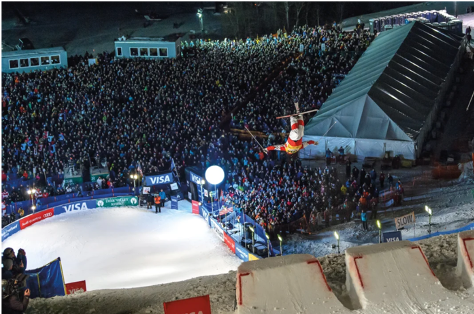A Performance Guide To Managing Transmeridian Travel - Part III
It is late January 2018. The Winter Olympic Games in PyeongChang, South Korea are a mere month away and the U.S. Freestyle Moguls Team has just finished a single day of competition in Calgary, Canada. The team performed well with four Top-10 results. At 5:00pm that evening the team makes the 10-minute commute via a short walk and train ride to CrossFit Cityscape for an evening training session. We are set to depart the next day. When available, I will find a local CrossFit facility in which to train; they offer consistent equipment selection, at a reasonable rental rate, and no general membership with which to compete.
The next morning, we load the rental cars outside the Westin and drive to Calgary International Airport. The weather in Calgary is beautiful, albeit brisk, and we anticipate arriving in Salt Lake City at our scheduled time. The athletes are excited to compete in Utah and Deer Valley is one the
After checking our bags at the WestJet counter, we proceed through security and to our gate. You can feel the excitement in the team. They are looking forward to getting to the team hotel and getting ready to train the next day. While we wait, I use the time to prepare for our arrival. Specifically, I am looking for space and equipment for light movement, warm-up, and recovery activities.most exciting stops on the World Cup Tour; not to mention it is our only “home game” each season (Image below).

As expected, we board in a timely fashion and hit our 5:00pm departure on time. The flight time from Calgary to Salt Lake City is just two hours and five minutes. I am excited to see my family. I will be hugging my wife and daughter before bed! An hour into the flight, the captain’s voice comes over the intercom. We have been diverted to Boise, Idaho. As it turned out, the inversion in Salt Lake City was impeding visibility to such a degree that flights were prohibited from landing. So, as in Part I and Part II, we are forced to adapt!
The flight lands in Boise without incident. Those who were sleeping are rather confused; offering us the opportunity for an extended prank. After deboarding, we are left with a choice – do we wait for another flight or do we rent cars and drive the last five and half hours. Given the unpredictability of the flight schedule and the fact we are expected to train the following day it is a difficult choice. We take a moment to speak with an airline representative. They agree to ship our bags, all 50 or more of them, to our front doors by the next day. Luckily, we had already cleared customs in Calgary, or this would not have been an option.
We proceed as a group to the rental car counter. One large van for athletes and a Dodge Ram for the carry-on gear and coaching staff. It is now about 8:00pm and we are on our way. The five-and-a-half-hour drive in the back seat of that Dodge Ram allows me to finalize preparations for our training schedule; including moving some equipment to the hotel and space and time arrangements for warm-up activities. We arrive at the Salt Lake City airport at about 1:30am and retrieve our personal vehicles. The final leg of the trip is a 30-minute drive up Parley’s Canyon to our home in Park City, Utah.
The next day, as promised, our bags arrive, including all the skis and training equipment. The team trains well and responds to our most recent travel challenge by posting five podium performances with eight top-10 results in two days of competition.
Planning Movement
Prior to each trip, which can often times lead us into a remote mountain town, I take time to plan. Foremost I prepare the team for travel using the resources in Part II and then I work to locate a local training facility and negotiate a reasonable rate for our visit. At each training camp, we will spend 10-15 days participating in strength and conditioning activities. While at a World Cup competition, World Ski Championships, or the Olympic Games we will spend anywhere from three to eight days participating in strength and conditioning activities. Planning on the front end is therefore, of the upmost importance.
After making facility arrangements, I pack my travel bag. I have one full size roller bag dedicated to physical preparation and monitoring of the team. Here is a list of my essentials:
- Gorilla Bow – If no gym is available
- BFR Straps/Cuffs – If needed
- Compex EMS Unit – If needed
- Lacrosse Ball (Foam Roller)
- Val Slides
- Suspension Trainer
- Dip Belt
- 41” Bands (½ inch and ¾ inch)
- Mini Bands
- Beast Sensor (VBT)
- iPad (data enabled)
- Urinalysis Test Strips
- Mini Bodyweight Scale
- Spare Heart Rate Monitor and batteries
Programming Training
Exercise is a critical component of managing jet lag and travel fatigue. Athletes who are more physically fit appear to handle the symptoms more efficiently, and adapt more quickly, than their less fit counterparts (Williams, Clarke, Aspe, & Cole, 2017). “Exercise has been clearly demonstrated to improve mood” (Meir, 2002, p. 30) and anecdotally, coaches, including myself, have reported that symptoms of jet lag can be reduced through systematic exercise prescription throughout the travel process.
Pre-flight
Preflight training modifications can be difficult to implement due to scheduling considerations. Often times, teams will train immediately following competition, and within 24 hours board a plane for the next destination or a return trip home. Therefore, coaches should consider the content of their preflight training sessions. It is generally recommended preflight routines incorporate reduced volume and intensities and when practical should coincide with training time at the upcoming destination (Samuels, 2012).
Above all else, athletes should be permitted to get enough sleep!
This may mean significantly reducing, and individualizing, your training plan based on prior and projected load and travel stress. It is also highly likely, on a long road trip, that one or more training sessions will be cancelled due to extraneous factors.
When preparation for travel is practical, it is generally considered seven days out from departure (Samuels, 2012). Begin to slowly adjust training times to match that of the destination; although you may never achieve a complete shift, simply switching from an afternoon training time to a morning training time over a week can help athletes adjust more quickly upon arrival.
During Transit
Encourage athletes to get up and move about the cabin inflight when appropriate and when it does not interfere with sleep. This becomes even more critical the larger the athlete. Walking and light stretching activities are recommended to promote blood flow and reduce the risk venous thromboembolism, joint stiffness, or muscle cramps that result from sitting during a long flight (Williams, Clarke, Aspe, & Cole, 2017). Consider the following movement options inflight:
- Walking
- Light stretching
- Standing Functional Range Conditioning (FRC) movements
Athletes should also be encouraged to move, stretch, or do isometric contractions in their seats if walking and standing are not permitted. Movement should be completed at regular intervals; I recommend every 60-90 minutes. Personally, I set a timer for 60 minutes and I advise my athletes to do the same provided they are not watching a movie. If athletes are watching a movie, this becomes much easier; simply instruct the athletes get up and move between movies.
A great opportunity for movement during transit is a layover. Layovers offer the opportunity for extended walks, stretching, and if planned correctly, athletes can pull a lacrosse ball from their carry-on for a light rolling session. I always carry a lacrosse ball and Skratch in my carry-on just in case athletes want to address their hydration or soft tissue.
Upon Arrival
Exercise recommendations upon arrival vary. Currently, recommendations exist regarding east-west vs. west-east travel and timing of exercise relative to direction of travel (Williams, Clarke, Aspe, & Cole, 2017). However, other studies have reported that exercise upon arrival might not reliably shift circadian rhythms (Lee & Galvez, 2012).
I have found the following exercise prescription to be the most effective method for managing jet lag during transmeridian and translongitudinal travel. Remember, the goal is to stay awake until a normal bedtime the first day – no matter what! When executed in the afternoon, strength and conditioning activities will help athletes stave off that deeply desired nap while at the same time, promoting blood flow and reducing muscle and joint stiffness.
Upon arrival at the final destination before 12:00pm:
- Arrival: Unpack and get organized
- Travel hygiene (see Part II)
- Before 12:00pm: 30-minute nap if needed
- After 12:00pm: DO NOT NAP!
- Dose caffeine if needed
- 3:00pm: Strength and Conditioning activity
- 9:00pm: Sleep
Upon arrival at the final destination after 12:00pm:
- Arrival: Unpack and get organized
- Travel hygiene (see Part II)
- DO NOT NAP!
- Dose caffeine if needed
- 3:00pm – 6:00pm (start time): Strength and Conditioning activity
- 9:00pm: Sleep
Upon arrival at the final destination after 9:00pm:
- Arrival: Unpack and get organized
- Travel hygiene (see Part II)
- Fuel if needed
- Sleep
My athletes prefer a variety of means for their light movement sessions upon arrival and I allow them the opportunity to choose based upon personal preference. Activity should remain low intensity and last between 30 and 60 minutes. My favorite activities for arrival day training include the following:
- A rousing game of follow the leader
- Sneak your mobility work in here!
- Yoga -using the Yoga Studio app
- FRC routine
- Zone 1 walk/light jog
- Hacky Sack
Fundamentally, strength training and conditioning activities during periods of extended travel need not be complicated. Travel stress and sleep loss are already going to test your athletes. Take the unknown off their plate; shoulder that burden for them by developing a set of plans regardless of the circumstances. As always, should you desire further information, I am happy to sit with you and/or your staff or send any resources you might need. I can be reached at JBullock.Publications@gmail.com or through my website at https://joshbbullock.wixsite.com/joshuabbullock. Safe travels!
Bibliography
Lee, A., & Galvez, J. (2012). Jet Lag in Athletes. Sports Health, 211-216.
Meir, R. (2002). Managing Transmeridian Travel: Guidelines for Minimizing the Negative Impact of International Travel on Performance. Strength and Conditining Journal, 28-34.
Reilly, T., & Piercy, M. (2007). The Effect of Partial Sleep Deprication on Weight-Lifting Performance. Ergonomics, 107-115.
Samuels, C. H. (2012). Jet Lag and Travel Fatigue: A Comprehensive Management Plan for Sport Medicine Physicians and High-Performance Support Teams. Clinical Journal Sports Medicine, 268-273.
Waterhouse, J., Reilly, T., Atkinson, G., & Edwards, B. (2007). Jet Lag: Trends and Coping Strategies. Lancet, 1117-1129.
Williams, B., Clarke, R., Aspe, R., & Cole, M. (2017). Managing Performance Through Periods of Travel. Strength and Conditioning Journal, 22-29.
Subscribe to our blog
Subscribe to receive the latest blog posts to your inbox every week.
Related posts

5 Step Framework for Training Youth Athletes

The Academic Calendar: An Underrated Training Tool


